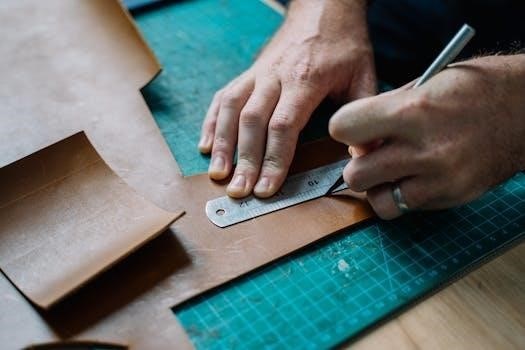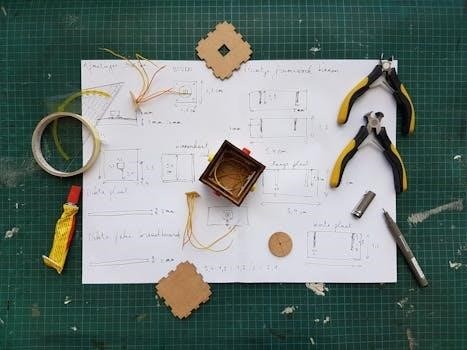Bread Maker Manual⁚ A Comprehensive Guide
Unlocking the secrets to perfect homemade bread begins with understanding your bread maker’s manual. This comprehensive guide offers valuable insights into its functions, troubleshooting, and maintenance. Refer to this manual for optimal bread-making.
Understanding Your Bread Maker
Your bread maker is more than just an appliance; it’s a gateway to fresh, homemade bread. To fully utilize its potential, a thorough understanding of its components and functions is essential. Begin by carefully reviewing your bread maker’s manual, paying close attention to the safety instructions and operating guidelines.
Familiarize yourself with the control panel, understanding the various settings and programs available. Most bread makers offer a range of options, from basic white bread to whole wheat, French bread, and even dough-only cycles. The manual will explain the specific settings and their corresponding baking times.
Pay attention to the capacity of your bread maker. Overfilling or underfilling the bread pan can affect the final product. The manual will specify the maximum and minimum amounts of ingredients recommended for each recipe. Also, understand the delay timer function, allowing you to schedule baking for a later time. Master every bread-making moment!
Identifying Bread Maker Components
Before embarking on your bread-making journey, it’s crucial to identify and understand the function of each component of your bread maker. The primary components include the bread pan, kneading paddle, control panel, heating element, and housing. The bread pan is where the ingredients are combined and baked, while the kneading paddle mixes and kneads the dough.
The control panel allows you to select the desired baking program, crust color, and loaf size. The heating element provides the heat necessary for baking, and the housing encases all the components. Some bread makers may also include additional features, such as a fruit and nut dispenser or a viewing window.
Refer to your bread maker’s manual for a detailed diagram and explanation of each component. Understanding the purpose of each part will enable you to operate your machine effectively and troubleshoot any potential problems that may arise. Remember always unplug your bread maker before cleaning or maintenance!
Bread Pan and Kneading Paddle
The bread pan and kneading paddle are two of the most critical components of your bread maker. The bread pan, typically non-stick, serves as both the mixing bowl and baking container. Ensure it’s securely locked into the bread maker before starting any cycle. Inspect it regularly for scratches or damage to the non-stick coating, which could affect baking performance and cleaning.

The kneading paddle, usually located in the center of the bread pan, is responsible for mixing and kneading the dough. It’s essential to use the correct paddle for your specific bread maker model. After baking, the paddle may sometimes get stuck in the loaf. Refer to the troubleshooting section of your manual for tips on how to remove it.
Both the bread pan and kneading paddle require proper cleaning and maintenance. Always allow them to cool completely before washing. Use warm, soapy water and a non-abrasive sponge to avoid damaging the non-stick surface. Some models may have dishwasher-safe components; check your manual for specific instructions.
Essential Bread Maker Functions
Your bread maker offers a range of functions designed to simplify the bread-making process. Understanding these functions is crucial for achieving consistent and delicious results. The primary function is, of course, basic bread baking, where the machine handles all stages from kneading to baking. Different models offer various pre-programmed settings for white bread, whole wheat, French bread, and more.
Another essential function is the dough-making option. This allows you to prepare dough for pizza, rolls, or other baked goods without baking them in the bread maker. The delay timer function lets you set the bread maker to start baking at a later time, ensuring fresh bread whenever you want it.
Familiarize yourself with these functions by consulting your bread maker manual. Each model may have slightly different options and controls, so understanding your specific machine is key; Experiment with the various settings to discover your favorite bread types and baking preferences.
Basic Bread Baking
The core function of any bread maker is, undeniably, basic bread baking. This automated process takes the guesswork out of making bread, allowing you to enjoy fresh, homemade loaves with minimal effort. To begin, carefully measure your ingredients according to the recipe in your manual. Add them to the bread pan in the order specified, typically starting with liquids, followed by dry ingredients, and lastly, yeast.
Secure the bread pan into the bread maker and select the appropriate program for your desired bread type, such as white bread, whole wheat, or French bread. Choose your preferred crust color, ranging from light to dark. Press start, and the bread maker will handle the rest, from kneading and rising to baking.
The machine will signal when the bread is ready. Carefully remove the bread pan using oven mitts, and let the bread cool slightly before slicing and enjoying. Remember to consult your bread maker’s manual for specific instructions and recommended settings.
Dough Making Function
Beyond baking complete loaves, many bread makers offer a dedicated dough-making function. This feature allows you to utilize the bread maker’s kneading and rising capabilities for various dough-based recipes, such as pizza dough, rolls, or even pasta dough; To use this function, follow your recipe’s instructions for ingredient measurements and order.
Add the ingredients to the bread pan, then select the “dough” program on your bread maker. The machine will knead the dough for a set period, followed by a rising phase. Once the cycle is complete, remove the dough from the bread pan. It is now ready to be shaped and baked according to your chosen recipe.
The dough-making function eliminates the need for manual kneading, saving time and effort; Remember to check your bread maker’s manual for specific program durations and any recommendations for achieving optimal dough consistency. It is the base for a huge amount of recipes.

Delay Timer Function
One of the most convenient features of many bread makers is the delay timer function. This allows you to prepare your ingredients in advance and set the bread maker to begin baking at a later time, so you can wake up to fresh bread or have it ready when you get home.
To use the delay timer, first add all the ingredients to the bread pan according to your recipe. Then, select your desired baking program and use the timer buttons to set the delay time. This is the amount of time you want to pass before the bread maker starts baking. Be sure to account for the total baking time when setting the delay.
For example, if you want fresh bread at 7⁚00 AM and the baking cycle is 3 hours, you would set the delay timer for 10 hours if it is currently 9⁚00 PM. Avoid using the delay timer with recipes containing perishable ingredients like milk or eggs that could spoil if left at room temperature for extended periods.
Troubleshooting Common Bread Maker Problems
Even with careful use, you may encounter occasional problems with your bread maker. Understanding common issues and their solutions can save you time and frustration. This section outlines frequent problems and offers potential fixes.
One common issue is the paddle getting stuck in the baked bread. This often happens because the paddle bakes into the loaf. Letting the bread cool completely before removing it can sometimes help. If the paddle is still stuck, try using a utensil to gently dislodge it.
Another frequent problem is bread not rising. This could be due to expired yeast, incorrect measurements, or using the wrong type of flour. Always check the yeast’s expiration date and ensure accurate measurements. Using bread flour, which has a higher gluten content, can also improve rising. A dark or light crust may also occur due to too much sugar.
Paddle Stuck in Bread

One of the most common frustrations for bread maker users is finding the kneading paddle firmly lodged inside the freshly baked loaf. This happens as bread cools and contracts after baking, sometimes trapping the paddle. Here’s how to handle this situation effectively⁚
First, allow the bread to cool completely in the bread pan before attempting removal. This cooling period allows the bread to contract and potentially loosen its grip on the paddle. If the paddle remains stuck, try gently using a non-stick utensil, such as a spatula or plastic knife, to carefully loosen the bread around the paddle.
Avoid using sharp metal objects that could damage the bread pan’s non-stick coating. Sometimes, gently rotating the paddle back and forth can help break the seal. If all else fails, soaking the bottom of the loaf in warm water for a few minutes can help soften the bread and release the paddle.
Bread Not Rising
A disheartening experience for any bread maker enthusiast is when the bread fails to rise adequately. Several factors can contribute to this issue, and identifying the cause is crucial for achieving a perfectly risen loaf. One common culprit is inactive or expired yeast. Always check the yeast’s expiration date and ensure it’s properly stored in a cool, dry place.
Another factor could be the water temperature. If the water is too hot, it can kill the yeast, while water that is too cold may not activate it effectively. Refer to your bread maker’s manual for the recommended water temperature. Incorrect measurements of ingredients can also hinder the rising process.
Ensure you are using the correct ratios of flour, water, yeast, and other ingredients as specified in your recipe. Additionally, the type of flour used plays a vital role. Bread flour, with its higher gluten content, is generally recommended for bread making, as it provides the necessary structure for proper rising. Finally, ensure that your bread maker is functioning correctly, and the heating element is working.
Crust Too Dark or Light
Achieving the perfect crust color on your homemade bread is a delicate balance, and sometimes, the crust may turn out too dark or too light. If the crust is consistently too dark, several factors could be at play. One common cause is excessive sugar or sweeteners in the recipe. Sugar caramelizes during baking, leading to a darker crust. Try reducing the amount of sugar or honey in your recipe to see if that resolves the issue.
Another factor could be the bread maker’s crust control settings. Most bread makers offer options for light, medium, and dark crusts. Ensure you have selected the appropriate setting for your desired crust color. If the crust is too light, on the other hand, it could be due to insufficient sugar or too much humidity in the baking environment.
Try adding a small amount of sugar to the recipe or ensuring the bread maker is placed in a well-ventilated area. Also, check the bread maker’s manual for specific instructions on adjusting the crust color. Experimenting with slight adjustments to the recipe and settings can help you achieve the perfect golden-brown crust.
Cleaning and Maintenance
Proper cleaning and maintenance are crucial for extending the lifespan of your bread maker and ensuring optimal performance. Regular cleaning prevents the buildup of food particles and residue, which can affect the taste and quality of your bread. Always unplug the bread maker and allow it to cool completely before cleaning. The bread pan and kneading paddle are the components that require the most frequent cleaning.
These parts come into direct contact with the dough and can accumulate sticky residue. Wash the bread pan and kneading paddle with warm, soapy water after each use. Avoid using abrasive cleaners or scouring pads, as they can damage the non-stick coating. For stubborn residue, soak the bread pan and paddle in warm water for a few minutes before washing.

The exterior of the bread maker can be wiped down with a damp cloth. Ensure that no water enters the appliance’s internal components. Periodically check the heating element and remove any crumbs or debris. Following these cleaning and maintenance tips will keep your bread maker in top condition for years to come.
Cleaning the Bread Pan and Paddle
Maintaining a clean bread pan and kneading paddle is essential for both hygiene and the optimal performance of your bread maker. After each use, promptly remove the bread pan from the machine and detach the kneading paddle. Immediately rinse both components under warm water to prevent dough from hardening.
Wash the bread pan and paddle with warm, soapy water using a soft sponge or cloth. Avoid abrasive cleaners or scouring pads, as they can scratch or damage the non-stick coating. For stubborn, baked-on residue, soak the bread pan and kneading paddle in warm water for approximately 15-20 minutes before washing. This will help loosen the residue, making it easier to remove.
Ensure all soap residue is thoroughly rinsed away. Dry both the bread pan and kneading paddle completely before storing them or reassembling them in the bread maker. Periodically inspect the kneading paddle for any signs of wear or damage, and replace it if necessary to ensure proper kneading and mixing.
General Maintenance Tips
To ensure the longevity and efficient operation of your bread maker, regular maintenance is key. Always unplug the bread maker before cleaning or performing any maintenance tasks. Wipe down the exterior of the bread maker with a damp cloth after each use to remove any spills or splatters. Avoid immersing the bread maker in water or any other liquid.
Regularly check the heating element inside the bread maker for any signs of residue buildup. If necessary, gently wipe it clean with a dry cloth. Do not use any abrasive materials or cleaning agents on the heating element. Ensure the bread maker is stored in a cool, dry place when not in use. Avoid storing it in areas with high humidity or extreme temperatures.
Periodically inspect the power cord for any signs of damage. If the power cord is damaged, it should be replaced by a qualified technician. Following these simple maintenance tips will help keep your bread maker in good working condition for years to come.
Online Resources for Manuals
Finding a Lost Bread Maker Manual
Misplacing your bread maker manual can be frustrating, but thankfully, there are several avenues to explore in retrieving a copy. Start by checking the manufacturer’s website. Many manufacturers provide digital versions of their manuals for download, often in PDF format. Simply navigate to the support or documentation section of their website and search for your specific bread maker model.
If the manufacturer’s website doesn’t have the manual, try searching online databases of appliance manuals. Websites like ManualsLib or similar platforms often host a wide range of manuals for various appliances, including bread makers. You can also try a general internet search using the bread maker’s brand and model number, followed by “manual” or “instruction manual.”
Another option is to contact the retailer where you purchased the bread maker. They may be able to provide you with a copy of the manual or direct you to the manufacturer. Finally, consider reaching out to online forums or communities dedicated to bread making. Other users may have a copy of the manual for your model and be willing to share it.
